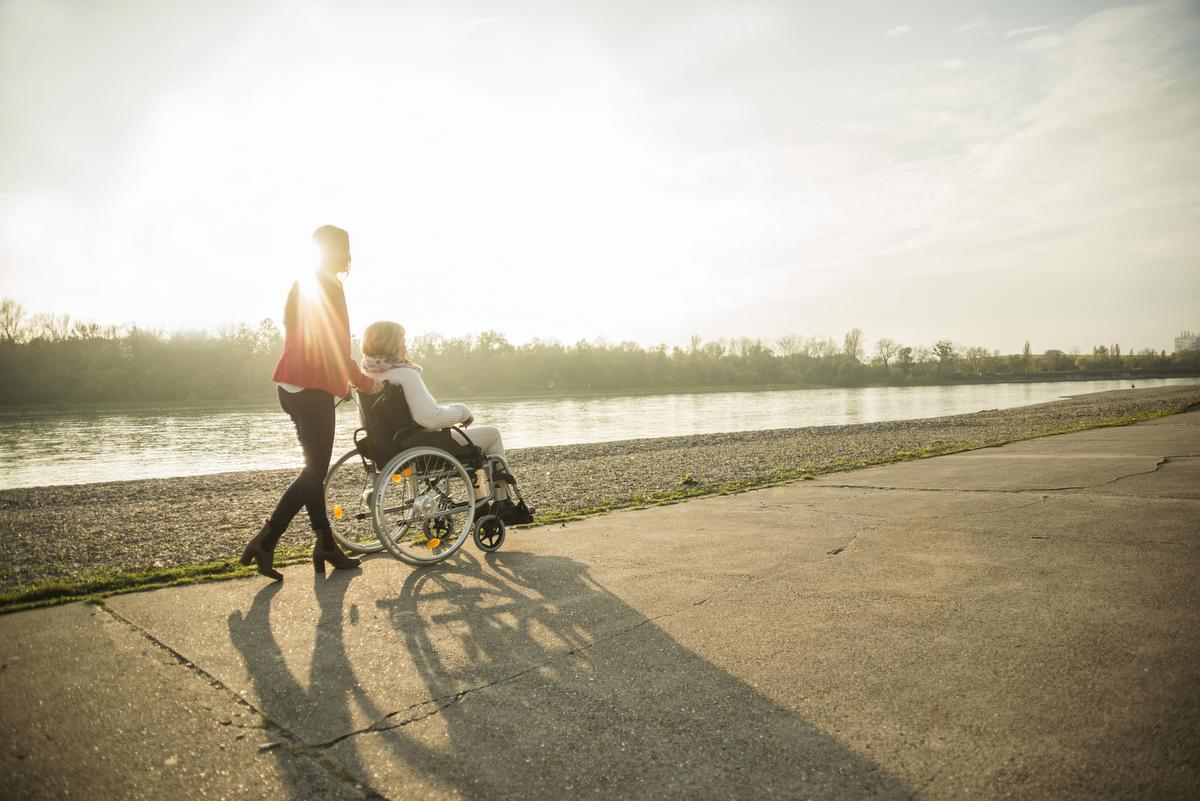‘Life or death’: People with a disability fear reopening as COVID lockdowns end


As residents across NSW celebrate an easing of restrictions, many of those living with a disability are left feeling forgotten, vulnerable and fearful for the future, according to disability advocates.
Advocates remain gravely concerned that sluggish efforts to vaccinate Australians living with a disability have left many facing sickness and death or crippling loneliness as they try to protect themselves.
They believe the state should have held off on reopening until all vulnerable members of the community had been vaccinated.
They stand behind the report handed down by the disability royal commission on 27 September, which described the vaccine rollout among those with a disability as “seriously deficient” and recommended the federal government “ensure people with disability and support workers are fully vaccinated before any easing of restrictions”.
“’Freedom day’ is ‘fear day’ for us because we’ve been left behind in the vaccine rollout,” People with Disability Australia (PWDA) president Samantha Connor told SBS News.
“A lot of people aren’t coping. A lot of people are feeling devalued and genuinely terrified for their lives,” she said.
“There are people with disabilities in NSW who have been locking down since the beginning of last year so when we have people going out and celebrating opening up, it feels like people are celebrating our imminent demise.”
“Lockdown was a preventative measure to keep people like us safe, it’s really hard.”
Mary Mallett, CEO of Disability Advocacy Network Australia, says the community is feeling “worried”.
“The government let down people with disability. People with disability and their families and advocates are really worried that many people are not adequately protected and will be a few months behind at least, which means they will not be able to join the rest of the NSW population in attending events, getting haircuts, going shopping, taking part in the community and society as they should be able to,” she said.
This means many could be left feeling even more isolated, Ms Mallett said.
“Some people will continue to isolate themselves as NSW opens up because of concern about the risk of contact with people who are unvaccinated. These are potentially life or death decisions, especially for immunocompromised people or those whose lung function means they would be less likely to recover from COVID-19,” she said.
Jim Simpson, senior advocate for Council for Intellectual Disability in NSW, said there is “grave concern” among those living with a disability and described their plight as “double jeopardy”.
“Either you get out and place yourself at risk or you continue to be down with the loneliness, the misery, and in a lot of cases the mental health problems that flow from that.”
“People are damned if they do and damned if they don’t.”
How many Australians with a disability are vaccinated?
While people with a disability living in shared accommodation, or “group homes” were included in phase 1a of the national vaccine rollout in January, they were later deprioritised in favour of aged care residents.
When asked about the health department’s progress in vaccinating Australians with a disability, NDIS Minister Linda Reynolds told SBS News the rollout had been a success.
“The Morrison government has made significant progress in vaccinating NDIS participants, with 74.4 per cent of 16 years olds and having had one dose and 56.3 per cent fully vaccinated,” she said.
This compares to 82.4 per cent of all Australians over 16 having received one dose, with 62.4 per cent now double vaccinated.
While the vaccination rate among NDIS participants is lower than the population as a whole, the statistics are misleading because only a small fraction of Australians living with a disability are actually eligible for the NDIS.
There are currently around 460,000 people on the NDIS whereas there are 2.2 million Australians living with a disability between the ages of 15 and 64.
And after the age of 65, one in two people have a disability.
This means the vaccination rate among Australians with disabilities as a whole is far lower, but data is not readily available.
Mr Simpson said the lag in the vaccine rollout for those living with a disability is “disturbing”.
He believes those with a disability should have remained in the phase 1a rollout with aged care residents.
“In January we had these two groups of equal priority so if they needed more resources to equally meet each of those priorities, they should have done so.”
While there has been a significant push in NSW to get vaccination teams to those living with a disability in recent weeks, “there is a long way to go”, according to Mr Simpson.
Shadow NDIS minister Bill Shorten told SBS News there had been a “monumental failing to protect Australians who are more vulnerable to COVID-19”.
“It’s important to vaccinate perfectly healthy people, but the whole reason we have gone through the trauma of lockdowns is to protect and vaccinate the vulnerable,” he said.
Those with a disability are more at risk
Many people living with a disability have immunocompromised conditions or medical conditions that put them at greater risk if they contract COVID-19.
Figures out of the UK show six out of 10 people who died with coronavirus in England in 2020 had a disability. That amounts to 30,296 of the 50,888 deaths between January and November, the Office for National Statistics shows.
At the same time, people with learning disabilities were up to six times more likely to die from COVID-19 during the first wave of the pandemic, according to a report from Public Health England, which also found the death rate for those with a learning disability was 30 times higher in the 18 to 34 age group.
“Unfortunately the more disabled you are, the more in danger you are,” Ms Connor said.
“The more support workers you have, the more people are coming to see you every day, the more transmission points you have. And this is multiplied in communal or shared living arrangements.”
Why is the vaccination rate lagging among Australians with a disability?
For many people living with a disability, getting a vaccine is not as simple as heading down to a vaccination centre or clinic.
“There are multiple barriers to vaccination including physical access to premises,” Mr Simpson said.
“For many people with an intellectual disability, it’s a very scary experience. So it’s a matter of creating a comfortable environment and offering reassurance to make it as easy for the person as possible.”
Ms Mallett said there can also be a lot of fear around vaccination and medical intervention in general.
“Some people with mental health conditions and psychosocial disability are wary of the health system and are very avoidant of any procedure. Again they will need people who know them … to encourage, prompt and support them to attend a vaccination clinic, or GP, or pharmacy,” she said.
Vaccine hesitancy can also be more apparent among people with a disability and those around them, she said.
“We have heard about some people with intellectual disability whose families are fearful of the vaccines and have not given consent for the person to be vaccinated,” Ms Mallett said.
“There seem to have been a minority of disability support workers who are hesitant about the vaccines and we have seen and heard of examples where their hesitancy has influenced some of the people with disability they work with. However, this seems to be changing over time.”
Sometimes it’s just hard to reach those living with disabilities, according to Ms Mallett.
“Some people lead quite isolated lives and do not have natural support from family and friends. An even greater effort is needed to contact people, through disability advocates and other services, who can give enough time and explain in the way best suited to the individual, what the vaccine is for, how it will protect them and how they can get it.”
How to support those living with a disability
Disability advocates are calling on state and federal health departments to ramp up efforts to ensure that all NDIS participants, disabled people and other at-risk individuals are prioritised for vaccination.
Minister Reynolds said the government “continues to prioritise vaccinations for people with disability, with more than 4,000 sites having received Commonwealth in-reach, as well as through state and community-based vaccination hubs specific to disability”.
NSW Minister for Families, Communities and Disability Services Alister Henskens said the rate of vaccination for people with a disability “has increased significantly in the last three months” but admits “there is still more work to do”.
“NSW agencies are working closely with the Commonwealth Department of Health, NDIA and National Disability Insurance Scheme providers to provide and promote a range of opportunities for home vaccination, increased supports to get people vaccinated and priority bookings at accessible vaccination centres,” he told SBS News.
Other state governments have put additional assistance in place.
Last week Victorian health authorities committed an additional $5 million towards 10 disability vaccination hubs and additional disability liaison officers to help people make bookings and arrange transport.
Meanwhile, Tasmania has added an accessible vaccination hub in the northern suburbs of Launceston, where there are high levels of people with a disability and inadequate transport options.
The federal government has also announced a rollout of text messages to people on the Disability Support Pension (DSP) to prompt them to get vaccinated, with the Disability Gateway to offer additional support in telling them where to go and how to make a booking.
“This is a practical response, which should have been done earlier,” Ms Mallett said. “We have asked that the people who are on JobSeeker, with partial capacity to work (in other words people who have a disability or chronic health condition but who have not been able to get onto the DSP) are also prioritised for the messages.”
At the end of the day, Ms Mallett said it’s up to all Australians to ensure our most vulnerable are protected from COVID-19.
“The best way for the rest of society to protect those living with a disability is to get vaccinated themselves,” she said.
Source: sbs.com.au




